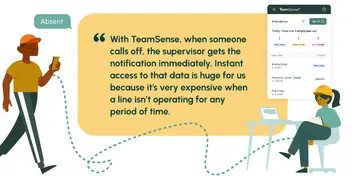Fix the root cause of No-Call No-Show with help from TeamSense
Company
The AZEK Company is a national manufacturer of outdoor living products and home-building materials. They are widely recognized for their composite decking products, sold under the TimberTech brand name. The company employs approximately 2,000 employees across the United States and Canada.
Challenge
Collecting call-off
data from call trees
was slow, inefficient,
and spotty.
As Senior Manager of HRIS at The AZEK Company, Tim Carracher enables the company’s workforce through pragmatic adoption of new technologies and data-driven insights. Recently, the HRIS function at The AZEK Company “shifted its focus from transactional processing to a more consultative type of service.”
With this renewed focus, Tim and the team became responsible for developing new processes and finding the right technology to fit the evolving needs of the organization, starting with the call-off process. For call-off management, the company was using a separate IVR system at each of their 15 plant locations. Each plant had its own phone number and call tree, meaning call-off data was siloed. HR teams then had to collect the data and share the information with each manager and supervisor as needed.
Tim even recalled that sometimes, employees wouldn’t even use the call tree—they’d call their manager directly—which meant that the data wouldn’t even make it back to HR. When this happened, it created downstream impacts, like blind spots for labor planning and time and attendance reporting.
When Tim joined the company, he saw a huge opportunity to consolidate the data and streamline the entire process. “TeamSense fit in really well with what we were trying to accomplish. We wanted to make the process of calling off easy and ensure that managers were receiving those notifications as soon as they occurred. We also wanted visibility for HR and to get the data in a structure that we can really work with.”
Solution
Consolidating call-off management and centralizing absence data
Tim and the AZEK HR team took a "big bang" approach to implementing TeamSense simultaneously across thirteen sites. The key to their success was following an effective change management strategy.
The implementation team trained internal champions to use TeamSense. Those champions talked to their peers and endorsed the experience, saying things like, "This works so much better. This is something that you should use too."
Today, Tim says the feedback on TeamSense has been very positive and that the vast majority of employees prefer TeamSense’s texting feature to the previous IVR system. “The amount of time it takes to get through the texting form versus having to go through the IVR call tree is so much quicker. It's incredible. It’s been a good experience for both the employees and the supervisors.”

Result
Reliable productivity for 24/7 operations
With TeamSense, The AZEK Company can now continuously access and analyze their call-off data. This has helped them in two ways
- By improving their “in-the-moment” staffing decisions
- By visualizing absence trends for proactive course correction
“There’s usually a small, 15-minute window between shifts when supervisors are planning for the next one. Knowing who’s late or absent factors into how we plan to keep the lines running 24/7. With TeamSense, when someone calls off, the supervisor gets the notification immediately. Instant access to that data is huge for us because it's very expensive when a line isn’t operating for any period of time,” Tim explains.
Aggregating the data and centralizing this information in their HR dashboards has also helped the AZEK team see patterns in behavior. “Attendance is a big driver of some of the key metrics we track, like retention and performance. With TeamSense, we can slice the data the way we want and see some of the trends at a
macro level.”
For example, they can see how absenteeism rates are trending for specific departments or locations, plus the reasons behind the absences. Armed with the data, HR and operations leaders are able to work together to take meaningful action.
Increasing engagement with hourly workers
TeamSense also helped The AZEK Company establish a new digital connection with the hourly workforce.
“We were using another system for general and emergency communications using phone numbers from our HR system, but we were noticing that those numbers were going out-of-date very quickly. With TeamSense, we always have their most up-to-date phone number because people need to call off. It’s been great,” Tim says.
TeamSense has given The AZEK Company the ability to reliably connect and engage with their workforce. They’ve since launched a monthly newsletter that employees can access via TeamSense’s employee portal, and the HR team uses broadcast messages to quickly communicate information like emergency plant closures, town halls, and even fun activities, like lunch-ins.
According to Tim, the data speaks for itself. “Looking at our yearly engagement survey results, we've definitely been trending in a positive direction. What we've seen from some of the comments is that people feel like they have a voice in the company. They feel like they now have the channels to express themselves and ways to connect to the company that they didn't have before.”
About the Author



